Have a stubborn tree stump on your property? Learn how to rot it out quickly!
If you’re reading this page, then you’ll likely also be interested in one of our many tree growing guides. For instance, learn how to successfully raise hickory trees.
Imagine this: A great storm is sweeping through your neighborhood. You can hear the wind howling and the rain hitting the windows of your house. The light is flickering, and dark clouds chase across the sky.
Then you hear the unmistakable, harrowing noise of tree branches crashing to the ground. When the storm is over, you find your favorite tree damaged beyond salvage. There is only one thing to do: Cut it down.
While the initial work to remove the tree is doable, you are left with an unsightly stump in your lawn.
The question now is how to remove that part of the tree so that you can begin restoring your yard to its usual glory.
In many instances, there are two quick and easy ways to get rid of the stump: grind it out or burn it out.
But what if that troublesome tree stump is close to your deck, shed, or even home? Grinders come with the risk of compromising the surrounding structure’s integrity. And a controlled burn so close to an essential part of your home is a dangerous prospect.
With the usual removal methods no longer practical, you might end up scratching your head.
Without question, the stump needs to be removed. Aside from being unsightly, its root system damage the foundation of your home. If left in the ground, this could prove to be very dangerous to you and your family.
Fortunately, there is another method of removal that you may not have considered. Simply put, you can rot it out of the ground.
Sure, removing wood this way will take a bit longer. However, when you consider the potential consequences of the alternatives—grinding or burning—the choice becomes clear.
Here you will find step-by-step instructions for rotting out a tree stump and everything you need to get the job done.
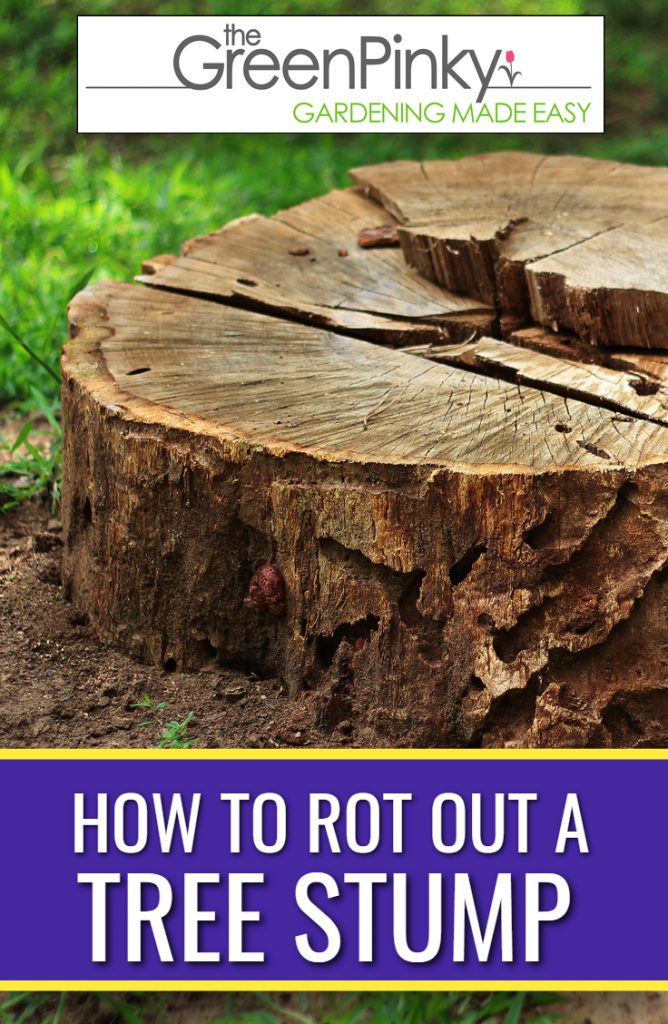
Different Chemicals You Can Use
You can choose different chemicals to do the job. The process of using them is the same, but the rate at which you see results varies dramatically. There are also some safety considerations for you to keep in mind when selecting the chemical to get rid of that pesky tree stump and its roots.
Potassium Nitrate
Potassium nitrate is an effective chemical for removing a tree stump close to your house. It is often explicitly sold as a wood remover.
Potassium nitrate stimulates wood decomposition and kills it completely. Its use will result in the fastest rotting process of the stump.
But potassium nitrate is a dangerous chemical. So you should make sure that you handle it with care. If you have children or pets, you may want to choose one of the other, less caustic compounds.
High Nitrogen Fertilizer
Stumps won’t stand a chance if you choose to use a high nitrogen fertilizer.
Both ammonium nitrate and ammonium sulfate are high nitrogen fertilizers and contain no phosphate or potassium. This nitrogen source will feed the fungi and bacteria that decompose wood.
Even healthy wood will decompose very quickly if you decide to use this compound.
Remember that these are also dangerous chemical compounds and should be handled with care and consideration for the people or pets around them.
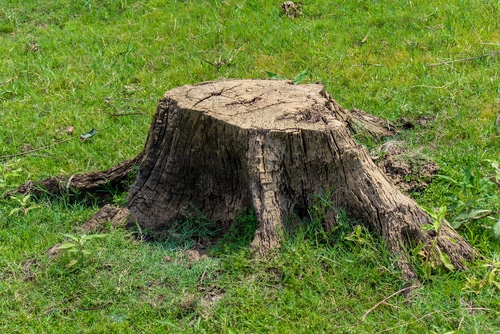
Bleach
Using bleach to rot out tree stumps is a method whose effectiveness depends on the tree in question. On some trees, it will work, and on others, it won’t. There’s no way to know how effective it will be ahead of time. So, you are looking at a trial by fire scenario.
Because bleach is caustic, it will rot wood at a moderate rate but not nearly as quickly as potassium nitrate or fertilizer.
Because bleach is a dangerous chemical, you should exercise care when using it around children or pets. Additionally, bleach could kill the plants in the surrounding area.
Epsom Salt or Rock Salt
Using one of these salts can be an effective way to remove a tree stump on your property.
Over time, the salt will deplete the wood of the nutrients it needs to live. However, when using one of these salts, the rotting process is slow. Out of all of these chemical compound choices, this method will take the longest.
But this is the most natural method of rotting wood, as the chemicals in these compounds are naturally occurring in the environment. So, if you have children or pets that will frequent the treated area, this is your safest choice.
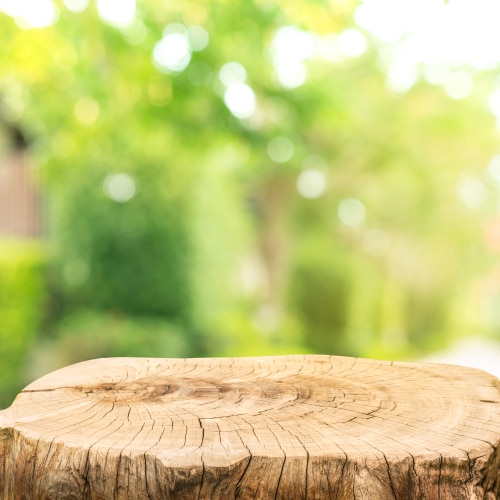
Make sure to learn about the many different types of boxwood that you can consider growing on your property.
Materials You Need for the Job
While the overall process may take some time, you won’t need much equipment to get the job done. Here is a list of all the materials you need:
- Drill and a large drill bit
- Hand-saw (you can use a chain-saw if you are very proficient)
- Tarp or other plastic cover
- Mulch
- Eye protection
- Gloves
Steps to Rot Out a Tree Stump
Follow these instructions to rot a tree stump out of the ground safely and effectively. Also, waiting for warmer weather conditions is probably a good idea as the higher humidity and heat can be helpful.
Step 1: Prepare the Stump
Using the hand-saw or chain-saw, cut what is left of the tree as close to ground level as you safely can.
The smaller the amount of wood you need to remove, the smaller the amount of time it will take to get rid of it.
Step 2: Drill the Holes
Using your drill and large bit, drill holes into the top of the stump. These holes should be no less than 3 to 4 inches deep. Space the holes about 2 inches apart and spread across the entire area.
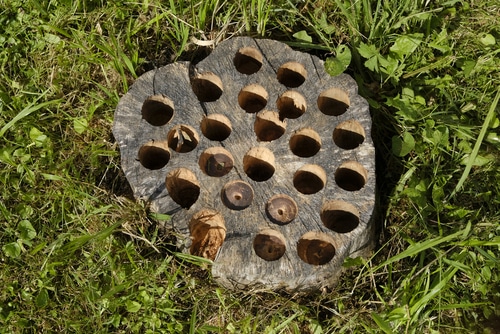
Step 3: Fill the Holes
This is where you select the appropriate chemical that safely and effectively suits your specific needs. Remember, the process for how all of the chemicals work is the same.
Fill each of the holes with water as it is needed for the chemical reaction to take place.
Next, add a generous amount of the chosen chemical into each hole you have drilled.
Step 4: Cover the Stump
Cover the stump and the surrounding area with the tarp to keep water from escaping.
Keeping the water under the tarp will keep the wood and soil moist. This will allow the chemical reaction to continue for an extended period of time.
This reaction is what will essentially dissolve the wood and roots.
Step 5: Break Out the Mulch
Cover the tarp and surrounding areas with a wood-chip-based mulch.
Once you have it covered, water the mulch thoroughly as it will also retain water and keep the grass and soil outside of the tarp moist. This will ensure that the chemical has enough moisture to continue reacting.
Follow Up Instructions
Depending on the chemical you chose, you will need to repeat Steps 3, 4, and 5 every month to a month and a half.
When you uncover the stump, you should notice that the rotting wood is soft and somewhat spongy. You need to remove this rotting timber with a hatchet or an ax. Then, it is time to drill new holes and fill them with water and chemicals. That way, the chemicals will be attacking fresh timber versus wood that has already rotted.
Once the wood has rotted to the ground level, you need one last, large batch of your chosen chemical and some water to finish the job. You can just leave the remainder to decay in the soil.
Depending on which chemical option you chose, it can take anywhere from a short 6 weeks to 12 months to rot a stump down to its roots.
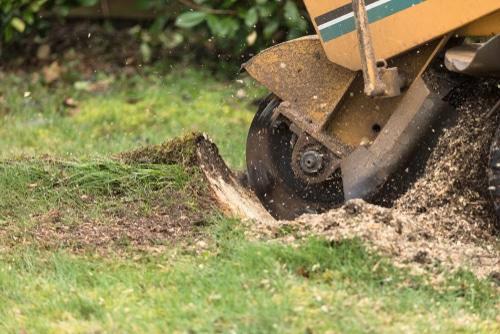
If you still have questions about removing a stump, you can always ask or hire a local tree service to help with the removal. Most tree removal companies will be happy to point you in the right direction regarding getting rid of the stump.

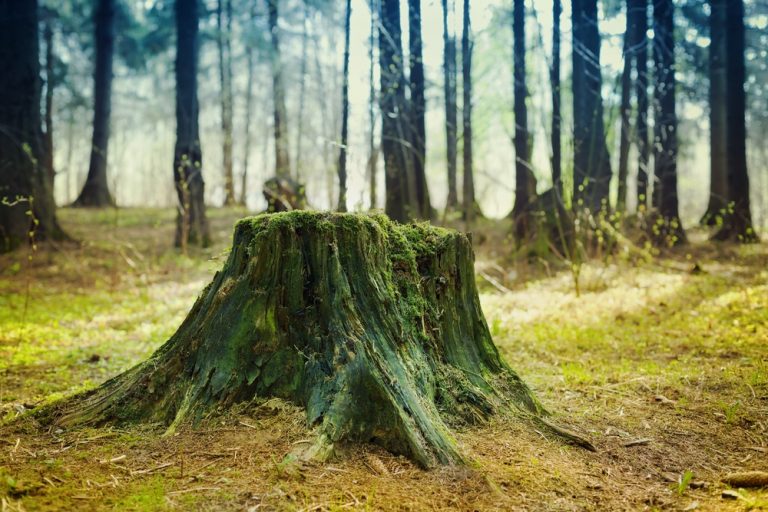
Will this work on stumps from laurel bushes?
Yes it will!
How simple is it to grow new grass over the stump remains if all of the stump is not totally ripped out from the ground?
Will this work on large mulberry stumps and large mesquite stumps?
If i had my tree stumps grounded but contractor did half a$$ job, is this still needed to get rid of the (exposed) tree roots in the ground?